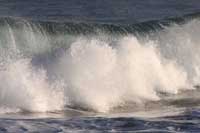Wave/Water Energy
 |
| Photo: stock xchng |
Background
Energy found in water (in
the form of motive energy or temperature differences) can
be harnessed and used to generate electricity. Since water
is about a thousand times denser than air, even a slow flowing
stream of water, or moderate sea swell can yield considerable
amounts of energy.
Prototype energy-harnessing buoys, that use a permanent
neodymium-iron-born magnet which is forced back and forth
through an electric coil by the modulation of waves, are
currently in use off the coast of Oregon. The researchers
believe such buoys could power about 20% of Oregon’s
electricity needs when fully implemented and operational.
This is currently the U.S.’s only university research
program into ocean wave energy extraction funded from federal
resources.
Impacts on birds
Now that the prototypes buoys have demonstrated their potential,
a study is underway to consider impacts on sea birds and
marine life from electromagnetic fields, construction, deployment,
and servicing of undersea cables.
In addition, the
Federal Energy Regulatory Commission has put the spotlight
on this potentially valuable source of renewable energy
by announcing an interim policy, and inviting public comment
on how to process preliminary permit applications for ocean
energy: wave, current, and instream hydropower technologies.
The Commissioners expressed interest in promoting these
technologies, but also concern about their reliability,
environmental and safety implications, and commercial viability.
There are two other
sources of energy from water
Tidal Power
It takes a high tide and a special configuration of the
coastline, a narrow estuary that can be dammed, to be
a tidal power site of value. Only about nine sites have
been identified in the world. Two are in use and generate
some electricity. Damming estuaries would have considerable
environmental impact. The Bay of Fundy in eastern Canada
has long been considered for a tidal power site, but developing
it would have a negative effect on the fisheries and other
sea-related economic enterprises. It would also disturb
the habits of millions of birds, which use the Bay of
Fundy as part of their migration routes.
Ocean Thermal Energy Conversion (OTEC)
Within about 25 degrees each side of the equator the surface
of the ocean is warm whereas the depths are cold. This
temperature differentialcan be a source of energy. A fluid
such as ammonia (which at normal atmospheric temperature
of 70 degrees Fahrenheit is a gas) is condensed by colder
water pumped from the ocean depth, and then leftt to warm
back up and turn to back gas. The resulting change in
gas pressure can move a turbine to turn a generator. But
the plant would have to be huge and anchored in the deep
open ocean subject to storms and corrosion, and the amount
of water that has to be moved is enormous, as the efficiency
is very low. OTEC does not appear to have much potential
as a significant energy source at this time.
|
